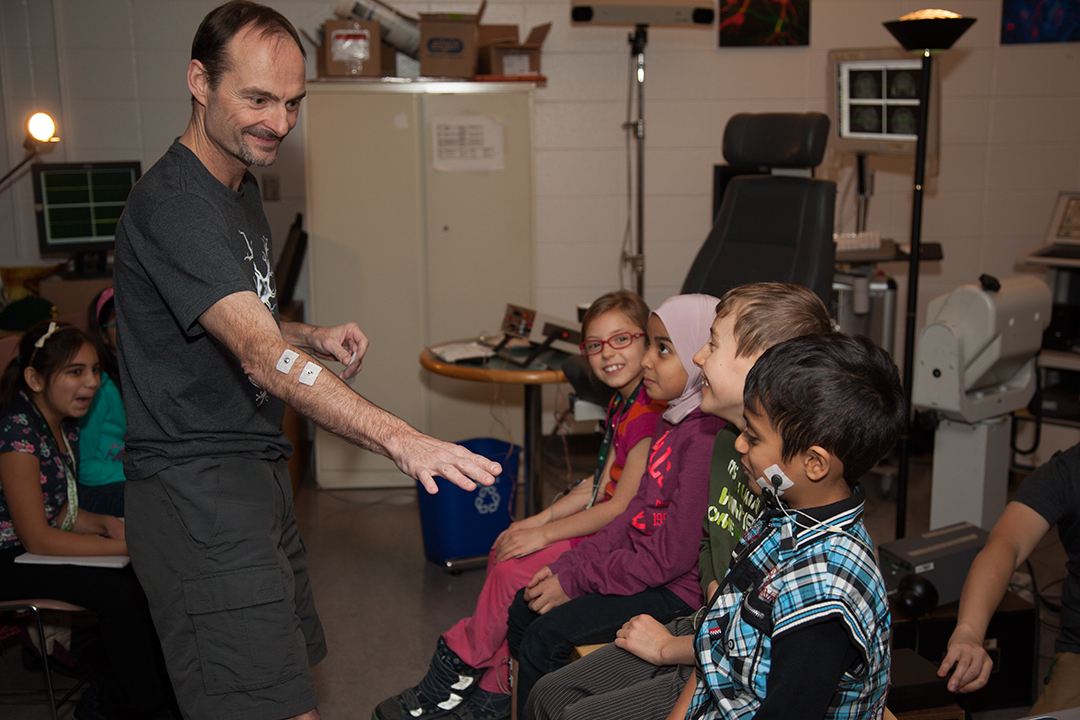
Dave Collins has spent the better part of his career finding ways to improve life-altering spinal cord injury side effects. He shares his passion of neuromuscular electrical stimulus with USchool participants
Bone loss, muscle deterioration and loss of muscle control are just some of the many challenges people with spinal cord injuries face. Faculty of Kinesiology, Sport, and Recreation professor, Dave Collins, has spent the better part of his career finding ways to improve these life-altering spinal cord injury (SCI) side effects.
Working with neuromuscular electrical stimulation (NMES), Collins has developed a novel therapeutic method that uses electrical impulses to stimulate deteriorating muscles to produce contractions by signals that travel along reflex pathways from the muscle, through the nervous system, and back to the muscle. According to Collins, the traditional application of NMES produces contractions by more directly stimulating the weakened muscles, but his approach looks reactivate circuits that control movement and re-establish the connection between the brain and the affected muscles and limbs.
"When you generate contractions through reflexes, you actually stimulate the muscle through pathways through the spinal cord as opposed to just through the stimulation of the muscle. This is a much more natural way to generate contractions because you're using the spinal cord rather than just activating the muscle."
Collins' approach for NMES was noticed by researchers in the United States who were looking at physical therapy and NMES as a way to treat people experiencing a SCI. Together, Collins and colleagues created a protocol that paired his NMES approach with a task-oriented physical therapy program as a way to rebuild muscle and bone, and recover function. Specifically, the protocol entails assessing the patient's injury-location and level of immobility-to determine where, what strength and how frequently to apply the electrical stimulus. From there, a task-oriented program is created for the patient. For example, if the patient's hand function is severely affected, a program that combines NMES with grasping tasks and exercises is applied.
"The idea is that right after injury, the person is combining stimulation with pretty rigorous physio--even if they can't move a whole lot, they're still trying and the theory is that they're still sending that signal from their brain to the muscle," says Collins, who recently received a 2018 TEC Edmonton Innovation Award for his work with NMES. "It's the pairing of the signals coming in from the limb with the signals coming from the brain that have to, overtime, re-establish those connections and strength those pathways."
Early trials done by Collins did show some positive results, but more work needs to be done to ensure that this protocol will rebuild muscle and bone, and improve function for SCI patients. While this protocol is still in the trial stages, Collins believes that as long as the trials show positive improvements for SCI patients, this treatment program can be used directly in hospitals, rehabilitations facilities and physiotherapy clinics.
"NMES is a type of stimulation physiotherapists are used to applying, so taking this protocol from the lab to clinical practice would be fairly seamless. In a situation where early and frequent movement is important for rehabilitation, this NMES and physiotherapy program when applied over three to six months could potentially have life-changing implications for individuals with a spinal cord injury."